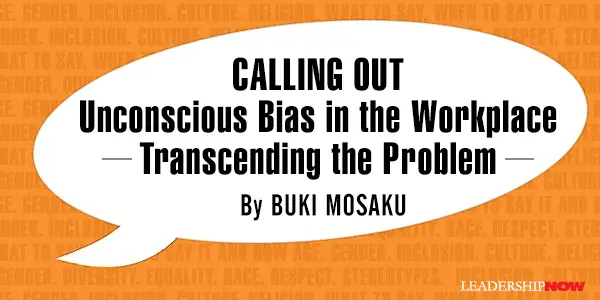
STATISTICS show that minorities and marginalized groups repeatedly experience career-stifling unconscious bias at many points throughout their working lives.
Women and ethnic monitories, for example, often find it hard to climb the career ladder — a fact borne out in the significant underrepresentation of both groups in senior leadership roles. Minorities also report being passed over in favor of white or male counterparts when the “good” assignments are given out. They’re also less likely to be given access to the multitude of career development opportunities that make a difference in earning potential.
Across sectors, minorities report that they:
- Are victims of insidious career-stifling impacts of everyday micro-aggressions
- Suffer from gender, racial, sexual orientation, disability, and other biases based on immaterial differences
- Must work twice as hard to build trust due to negative stereotypes and perceptions of what “credible” looks like to their superiors, colleagues, and the wider public
Certainly, many employers have taken some important steps to deal with career-stifling bias. While top-down initiatives will bear fruit in the long term, the trickle-down effect is too slow for those already falling victim to unconscious workplace bias.
So, what’s the answer?
Here are three power actions that differentiate high-performing minorities in calling out and navigating career-stifling unconscious bias in the workplace:
1. Understand the Problem of Unconscious Bias in the Workplace
On the basis that you can’t successfully address or tackle a problem that you don’t fully understand, it behooves everyone in the organization to be cognizant with this topic.
There are two forms of career-stifling unconscious bias:
Directional bias is unconsciously directed toward minorities in the workplace by leaders, potential clients, and clients based on conditioned negative stereotypes. This could show up as a lack of trust when potential clients hear an untraditional accent or are confronted with a female as opposed to a male practitioner. It can also reveal itself when minorities are overlooked for senior roles or for high-profile projects.
Reverse bias, is when a minority misinterprets unfavorable decisions or behaviors as driven by unconscious bias when they aren’t, in which case they become the perpetrator of bias as opposed to the victim.
For instance, an employee representing a marginalized group may presume a colleague has a problem with their accent when in reality, there’s no problem. Or, a minority senses unconscious discrimination when not being tapped for a promotion when it’s a case of simply not meeting the requirements of the role.
With this understanding, minorities can allow for misinterpretations of sensed bias and, in doing so, more effectively navigate sensed directional bias without turning into a perpetrator of bias themselves and invoking defensive fragility from the presumed perpetrator — in other words, getting the other person’s “back up.”
2. Call Out Sensed Unconscious Bias
Whenever you sense unconscious bias towards yourself or others, call it out in the moment. Don’t wait. If you don’t, you’re part of the problem. If you do, you’re part of the solution.
Here’s a step-by-step way to effectively call it out:
- Leave your own biases baggage (that you may understandably have every right to be carrying) at the door.
- Give the presumed perpetrator(s) the benefit of the doubt but call it out anyway. Start by turning this three-word statement into a question, asking: “I don’t understand?”, which allows for any misinterpretations of bias, but invokes an explanation or elaboration from the sensed perpetrator. Engaging in this dispassionate, developmental inquiry will eventually illuminate either directional bias or reverse bias.
- Focus on the issue at hand, not the problem of sensed bias. If, for example, you’re a minority and you sense discomfort regarding your accent from a client, focus on the client’s discomfort — not their problem with your accent.
- Agree on collaborative next steps, seeking “worthy recompense” if you are indeed the victim of unconscious bias, and move on.
3. Transcend the Problem
The first two practical steps are focused on navigating everyday bias in the moment, however, transcending workplace bias rapidly dissipates the issue in real time and completely removes the problem.
To do that, accept the unequivocal multidirectional nature of workplace bias. This means always allowing for the potential that you’ve misinterpreted the situation regardless of your certainty — that you might be engaging in reverse bias. When you do this, you strategically position yourself to advantageously call out bias any time you sense it without being accusatory in your approach and invoking defensive fragility in the sensed perpetrator.
When you apply these three powerful actions, your vision, and wisdom are unimpaired by majority guilt or minority pain and retribution. You focus on collaborative, progressive bias navigation in the moments you sense career-stifling workplace bias.
Practice navigating everyday bias until the approach becomes second nature. Don’t be shy — give it a try!

Buki Mosaku is the Founder and CEO of London-based DiverseCity Think Tank, a workplace-bias and diversity-and-inclusion consultancy. He is one of the world’s foremost bias-navigation experts. Mosaku has cracked the code for calling out unconscious workplace bias and stopping it in its tracks, which he details in his book, I Don’t Understand: Navigating Unconscious Bias in the Workplace (Business Expert Press). Learn more at www.bukimosaku.com.
Follow us on Instagram and Twitter for additional leadership and personal development ideas.
This content was originally published here.



Comments are closed, but trackbacks and pingbacks are open.